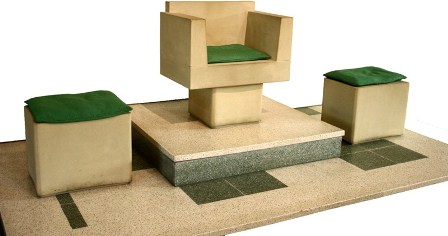The Celebrant's Chair.

The chair of the priest celebrant must signify his office of presiding over the gathering and of directing the prayer. Thus the best place for the chair is in a position facing the people at the head of the sanctuary, unless the design of the building or other circumstances impede this: for example, if the great distance would interfere with communication between the priest and the gathered assembly, or if the tabernacle is in the centre behind the altar. Any appearance of a throne, however, is to be avoided.
General Instruction of the Roman Missal 310.
The history of the celebrant's chair goes back to the early church and possibly pre-dates the use of fixed altars and the chairs provided for bishops. In style they were meant to represent the role of the bishop as philosopher, teacher and judge. The principal celebrant at the Mass, if he is preaching, may still deliver the homily from the chair. The fixed position was arranged so that the bishop would best be able to preside and preach from there. Later, as ordained priests began representing the bishop and helping him with his pastoral duties outside the cathedral places of presiding for them. Over the centuries the role of the chair diminished until it became a place for the priest to ‘take a break’ while someone else did something. Again, following the Second Vatican Council, the role of the priest came back to one of presiding over a joint act or worship – the people in the pews again had a real and active role to play rather than just being passive attendees. With that the presidential chair was brought back onto the sanctuary. It is now as much a focus of the liturgical action of the Mass as are the altar and the ambo.
From the chair the priest will lead the Introductory and Concluding Rites, say the Prayer after Communion and will preside over the Liturgy of the Word. As mentioned above, if he chooses he may deliver the Homily from the Chair, either standing or sitting. The chair is there to confer dignity to the celebrant's role as our leader in worship. It should look different from seats used by other ministers helping on the sanctuary. For this reason the chair should never be used by a lay person even if they are leading an act of worship.
The present chair was again another addition to the fabric of the church in preparation for its Consecration its wooden predecessor being being retired from use. The choice of material used was delibarate - the use of the same stone in the altar, chair, ambo and font symbolising and stressing the unity of the four areas of liturgical action.